RIPARIAN PLANTS IN URABNIZATION OF KHONG-RANGSIT PAYULSAK, PATHUM THANI PROVINCE
Keywords:
Riparian plants, urbanization, species diversityAbstract
The main cause of impact on biological diversity is land use change. The area along the Rangsit canal is the area to support the expansion of Bangkok. In addition to the problems of river bank erosion have been increased every year. Riparian plants are part of the maintenance of subsidence of the river bank. Therefore, this research explores the diversity of species of riparian plants at Klong Rangsit Prayoonsak in 32 samples in Pathum Thani province. The systematic surveying is line transect sampling, size 1 x 1 meter, and analyze including density, frequency, relative dominance, and important value index (IVI). 44 plants 17 families were found, and the top 5 riparian plants were Brachiaria mutica (Forssk.) Stapf, Cyperus mitis Steud, Alternanthera philoxeroides (Mart.) Griseb, Cleome rutidosperma DC. and Boerhavia diffusa L., respectively. The results found that the urbanization affects the number of species of riparian plants, which the number of species were decrease according to the density of habitat.
References
Chayamarit K. Handbook of Plant Classification. Bangkok: Diamond Printing Co.,Ltd.: 1998.
David PT, Penelope GA, Angela MG et al. Riparian plant invasions: hydrogeomorphological control and ecological impacts. PPG: Earth and Environment. 2001; 25(1): 22-52.
eFloras. Flora of China, 2008. Available at: http://www.efloras.org. Accessed May 20, 2019.
Hood WG, Naiman RJ. Vulnerability of riparian zones to invasion by exotic vascular plants. Plant Ecology. 2000; 148: 105–114.
Kutintara U. Ecology fundamental basics in forestry. Department of Forest Biology. Faculty of Forestry, Kasetsart University. Bangkok: 1998.
Mckinney ML. Urbanization, Biodiversity, and Conservation. BioScience: 2002; 52(10): 883-890.
National Research Council. Riparian Areas: Functions and Strategies for Management. Washington, DC: The National Academies: 2002.
Pattarakulpisutti P, Samala S, Wuttipong P. Diversity of vascular plants in floodplain vegetation in Nong Thung Tong Non-hunting Area, Surat Thani Province. Department of National Parks, Wildlife and Plant Conservation: 2015.
Smart S, Thompson K, Marrs R. et al. Biotic homogenization and changes in species diversity across human-modified ecosystems. Proceedings of the Royal Society: Biologial Sciences. 2006; 273: 2659-2665.
Sukwong S. Forest Ecology: Practical Field Guideline in Summer Term. Department of Forest Biology, Faculty of Forestry, Kasetsart University: 1977.
Suwanarit A. The Urban Evolution in Tung Rangsit and Bangkok’s Green Suburb Dynamic. Academic journal Faculty of Architecture Chulalongkorn University. 2010; 1: 119-130.
Teerawattananon A., Chantarasuwan B., Sungkaew S. Undergrowth plants. Bangkok: Advertising company, 2013: 293
Tongcumpou C, Sampanpanish P. Water Use Pattern of The Irrigation Area in Klong Rung Sit Tai. Environmental Research Institute Chulalongkorn University, 1998.
Watts S, Ovalle DH, Herrera MM. et al. Pollinator effectiveness of native and non-native flower visitors to an apparently generalist Andean shrub, Duranta mandonii (Verbenaceae) Plant Species Biology. 2012; 27: 147–158.
Werukamkul P, Ampornpan L. Plant Diversity in Wetland of Na Haeo District, Loei Province. Burapha Science Journal. 2013: 18(1): 82-94.
Downloads
Published
How to Cite
Issue
Section
License
Each article is copyrighted © by its author(s) and is published under license from the author(s).










